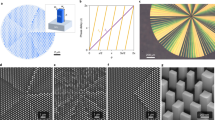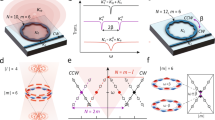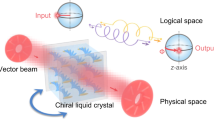Abstract
Photons that have a helical phase front, that is, twisted photons, can carry a discrete, in principle, unlimited, but quantized amount of orbital angular momentum (OAM). Hence, twisted single photons constitute a high-dimensional quantum system with information-processing abilities beyond those of two-level single-photon qubits. To date, the generation of single photons carrying OAM has relied on a non-linear process in bulk crystals, for example, spontaneous parametric down-conversion, which limits both the efficiency and the scalability of the source. Here, we present a bright solid-state source of single photons in an OAM superposition state with a single-photon purity of g(2)(0) = 0.115(1) and a collection efficiency of 23(4)%. The mode purity of the single-photon OAM states is further examined via projection measurements. Future developments of integrated quantum photonic devices with pure OAM states as an additional degree of freedom may enable high-dimensional quantum information processing.
This is a preview of subscription content, access via your institution
Access options
Access Nature and 54 other Nature Portfolio journals
Get Nature+, our best-value online-access subscription
$29.99 / 30 days
cancel any time
Subscribe to this journal
Receive 12 print issues and online access
$259.00 per year
only $21.58 per issue
Buy this article
- Purchase on Springer Link
- Instant access to full article PDF
Prices may be subject to local taxes which are calculated during checkout





Similar content being viewed by others
Data availability
The datasets generated and/or analysed during the current study are available at https://doi.org/10.6084/m9.figshare.13285514.v2.
References
Allen, L., Beijersbergen, M. W., Spreeuw, R. J. C. & Woerdman, J. P. Orbital angular momentum of light and the transformation of Laguerre-Gaussian laser modes. Phys. Rev. A 45, 8185–8189 (1992).
Wang, J. et al. Terabit free-space data transmission employing orbital angular momentum multiplexing. Nat. Photon. 6, 488–496 (2012).
Bozinovic, N. et al. Terabit-scale orbital angular momentum mode division multiplexing in fibers. Science 340, 1545–1548 (2013).
Mair, A., Vaziri, A., Weihs, G. & Zeilinger, A. Entanglement of the orbital angular momentum states of photons. Nature 412, 313–316 (2001).
Vallone, G. et al. Free-space quantum key distribution by rotation-invariant twisted photons. Phys. Rev. Lett. 113, 060503 (2014).
Bechmann-Pasquinucci, H. & Tittel, W. Quantum cryptography using larger alphabets. Phys. Rev. A 61, 062308 (2000).
Cerf, N. J., Bourennane, M., Karlsson, A. & Gisin, N. Security of quantum key distribution using d-level systems. Phys. Rev. Lett. 88, 127902 (2002).
Romero, J., Giovannini, D., Franke-Arnold, S., Barnett, S. M. & Padgett, M. J. Increasing the dimension in high-dimensional two-photon orbital angular momentum entanglement. Phys. Rev. A 86, 012334 (2012).
Chen, L. et al. Experimental ladder proof of Hardy’s nonlocality for high-dimensional quantum systems. Phys. Rev. A 96, 022115 (2017).
Krenn, M., Handsteiner, J., Fink, M., Fickler, R. & Zeilinger, A. Twisted photon entanglement through turbulent air across Vienna. Proc. Natl Acad. Sci. USA 112, 14197–14201 (2015).
Krenn, M. et al. Twisted light transmission over 143 km. Proc. Natl Acad. Sci. USA 113, 13648–13653 (2016).
Sit, A. et al. High-dimensional intracity quantum cryptography with structured photons. Optica 4, 1006–1010 (2017).
Mirhosseini, M. et al. High-dimensional quantum cryptography with twisted light. New J. Phys. 17, 033033 (2015).
Wang, X. L. et al. Quantum teleportation of multiple degrees of freedom of a single photon. Nature 518, 516–519 (2015).
Stav, T. et al. Quantum entanglement of the spin and orbital angular momentum of photons using metamaterials. Science 361, 1101–1104 (2018).
Wang, X. L. et al. 18-Qubit entanglement with six photons’ three degrees of freedom. Phys. Rev. Lett. 120, 260502 (2018).
Ding, X. et al. On-demand single photons with high extraction efficiency and near-unity indistinguishability from a resonantly driven quantum dot in a micropillar. Phys. Rev. Lett. 116, 020401 (2016).
Unsleber, S. et al. Highly indistinguishable on-demand resonance fluorescence photons from a deterministic quantum dot micropillar device with 74% extraction efficiency. Opt. Express 24, 8539–8546 (2016).
Senellart, P., Solomon, G. & White, A. High-performance semiconductor quantum-dot single-photon sources. Nat. Nanotechnol. 12, 1026–1039 (2017).
He, Y. M. et al. Deterministic implementation of a bright, on-demand single-photon source with near-unity indistinguishability via quantum dot imaging. Optica 4, 802–808 (2017).
Wang, H. et al. Boson sampling with 20 input photons and a 60-mode interferometer in a 1014-dimensional Hilbert space. Phys. Rev. Lett. 123, 250503 (2019).
Liu, J. et al. Cryogenic photoluminescence imaging system for nanoscale positioning of single quantum emitters. Rev. Sci. Instrum. 88, 023116 (2017).
Cai, X. et al. Integrated compact optical vortex beam emitters. Science 338, 363–366 (2012).
Strain, M. J. et al. Fast electrical switching of orbital angular momentum modes using ultra-compact integrated vortex emitters. Nat. Commun. 5, 4856 (2014).
Miao, P. et al. Orbital angular momentum microlaser. Science 353, 464–467 (2016).
Zhang, J. et al. An InP-based vortex beam emitter with monolithically integrated laser. Nat. Commun. 9, 2652 (2018).
Fickler, R. et al. Quantum entanglement of high angular momenta. Science 338, 640–643 (2012).
Strauf, S. et al. Self-tuned quantum dot gain in photonic crystal lasers. Phys. Rev. Lett. 96, 127404 (2006).
Liu, J. et al. A comparison between experiment and theory on few-quantum-dot nanolasing in a photonic-crystal cavity. Opt. Express 21, 28507–28512 (2013).
Blakemore, J. S. Semiconducting and other major properties of gallium arsenide. J. Appl. Phys. 53, R123 (1982).
Gehrsitz, S. et al. The refractive index of AlxGa1−xAs below the band gap: accurate determination and empirical modeling. J. Appl. Phys. 87, 7825 (2000).
Zhu, J., Chen, Y., Zhang, Y., Cai, X. & Yu, S. Spin and orbital angular momentum and their conversion in cylindrical vector vortices. Opt. Lett. 39, 4435–4438 (2014).
Zhu, J., Cai, X., Chen, Y. & Yu, S. Theoretical model for angular grating-based integrated optical vortex beam emitters. Opt. Lett. 38, 1343–1345 (2013).
Moreno, I., Davis, J. A., Ruiz, I. & Cottrell, D. M. Decomposition of radially and azimuthally polarized beams using a circular-polarization and vortex-sensing diffraction grating. Opt. Express 18, 7173–7183 (2010).
Gibson, G. et al. Free-space information transfer using light beams carrying orbital angular momentum. Opt. Express 12, 5448–5456 (2004).
Yue, Y. et al. Mode properties and propagation effects of optical orbital angular momentum (OAM) modes in a ring fiber. IEEE Photon. J. 4, 535–543 (2012).
Li, S. & Wang, J. A compact trench-assisted multi-orbital-angular-momentum multi-ring fiber for ultrahigh-density space-division multiplexing (19 rings × 22 modes). Sci. Rep. 4, 3853 (2014).
Vasnetsov, M. V., Pas’ko, V. A. & Soskin, M. S. Analysis of orbital angular momentum of a misaligned optical beam. New J. Phys. 7, 46 (2005).
Winger, M. et al. Explanation of photon correlations in the far-off-resonance optical emission from a quantum-dot–cavity system. Phys. Rev. Lett. 103, 207403 (2009).
Zhou, Z. Y. et al. Orbital angular momentum photonic quantum interface. Light Sci. Appl 5, e16019 (2016).
Liu, S. et al. Coherent manipulation of a three-dimensional maximally entangled state. Phys. Rev. A 98, 062316 (2018).
Heindel, T. et al. Electrically driven quantum dot-micropillar single photon source with 34% overall efficiency. Appl. Phys. Lett. 96, 011107 (2010).
Yuan, X. et al. Uniaxial stress flips the natural quantization axis of a quantum dot for integrated quantum photonics. Nat. Commun. 9, 3058 (2018).
Zhang, Z. et al. Tunable topological charge vortex microlaser. Science 368, 760–763 (2020).
Acknowledgements
J.L. thanks Y. F. Xiao, C. H. Dong, Z. Y. Zhou and X. Cai for helpful discussions. This work is supported by the National Key R&D Program of China (2016YFA0301300 and 2018YFA0306100), the Key-Area Research and Development Program of Guangdong Province (2018B030329001), the National Natural Science Foundation of China (91750207, 11874437 and 62035017), the Guangzhou Science and Technology project (201805010004), the Natural Science Foundation of Guangdong (2018B030311027) and the National Supercomputer Center in Guangzhou.
Author information
Authors and Affiliations
Contributions
X.W. presented the idea. J.L. and X.W. conceived the project. J.L. directed the experiment. B.C. and S.L. contributed to the structure simulations. Y.Y. grew the quantum dot wafers. B.C., R.S., J.L. and B.Y. fabricated the devices. B.C., J.L. and Y.W. characterized the devices. B.C., J.L., T.Z., X.W. and Y.W. analysed the data. J.L. wrote the manuscript with inputs from all authors. J.L. and X.W. supervised the project.
Corresponding authors
Ethics declarations
Competing interests
The authors declare no competing interests.
Additional information
Peer review information Nature Nanotechnology thanks the anonymous reviewers for their contribution to the peer review of this work.
Publisher’s note Springer Nature remains neutral with regard to jurisdictional claims in published maps and institutional affiliations.
Supplementary information
Supplementary Information
Supplementary Figs. 1–14, discussion and refs. 1–11.
Rights and permissions
About this article
Cite this article
Chen, B., Wei, Y., Zhao, T. et al. Bright solid-state sources for single photons with orbital angular momentum. Nat. Nanotechnol. 16, 302–307 (2021). https://doi.org/10.1038/s41565-020-00827-7
Received:
Accepted:
Published:
Issue Date:
DOI: https://doi.org/10.1038/s41565-020-00827-7
This article is cited by
-
Integrated optical vortex microcomb
Nature Photonics (2024)
-
Arbitrarily structured quantum emission with a multifunctional metalens
eLight (2023)
-
Highly-twisted states of light from a high quality factor photonic crystal ring
Nature Communications (2023)
-
Metafiber transforming arbitrarily structured light
Nature Communications (2023)
-
Nanophotonic nonlinear and laser devices exploiting bound states in the continuum
Communications Physics (2022)



